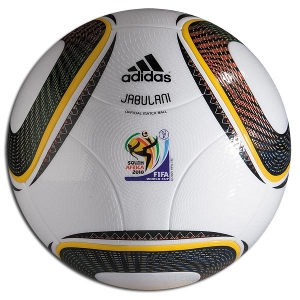The Physics of the Jabulani ball
When you look closely at a Jabulani ball you will notice the fact that it is pretty much a perfect sphere save for some mysterious grooves carved into the surface. These grooves play the same role as the dimples on a golf ball --that is they reduce drag.
They had to put the grooves in precisely because it was perfectly spherical. It has no panels at all. The stitching is on the inside. So you have this very spherical ball and when you kick it, there should be no ambiguity about the point and direction at which you hit the ball. On a paneled ball, there is ambiguity, as the direction is affected by the position of the panels relative to your foot. Spherical symmetry removes this ambiguity and so the ball should do what the player told it to do. But this ignores, crucially, and ridiculously, the subsequent flight. Spherical balls are less stable in flight because, counterintuitively, they feel more drag.
So they put the grooves in to counter this. This works as follows. There are two types of fluid flow. Laminar and turbulent. Surprisingly, laminar is bad, turbulent is good. Think of smoke rising from a fire. The smooth flow at the bottom is a laminar flow where as the messy, chaotic flow at the top is a turbulent flow. When a spherical ball moves through the air there is a laminar flow to the front, and turbulence behind. Turbulent flows store more kinetic energy, and by Bernoulli's principle, this results in a drop in pressure. So you have high pressure in front of the ball, low pressure behind--thats drag.
A golf ball's dimples and the jabulani's grooves are designed to get rid of the laminar flow at the front. You get turbulence all around the ball, and no pressure differentials, and therefore no drag. If you like, the ball wears a "coat of turbulence" that lets it slip through the air. Thus the ball moves through the air quicker and should be more stable . I think it is moving quicker, but I'm not sure about stability. The "supernatural" nature of the ball suggests that the grooves might not always be doing their job in stabilising the flight of the ball. For stability, the fact it is spherical seems to dominate what goes on and so you get some random movements.
But like I say, the grooves do seem to be reducing drag. The grooves also allow the ball to maintain its spin more easily, so the logic is that it should curve more. This is unbelievably naive though. Just think of adding velocities in mechanics. Sure, the ball can maintain spin, and spin gives you a larger transverse velocity due to the magnus effect. But the forward velociity is much much larger because of the reduced drag, so when you add the two velocities you don't see that much "curve". Have you noticed that footballs, in general, curve more at the end? This is because they have slowed down--the forward velocity has dropped and the transverse velocity becomes more noticeable. The jabulani doesn't lose much forward velocity, so it looks like it just keeps on going without much bend.
The spherical nature of the ball also makes it more difficult to apply the spin to the ball in the first place. Its too slippy--the grooves don't make it unslippy enough. You are much more likely to give the ball linear as opposed to angular momentum, and you need the latter to get the ball to bend.
You could adapt your technique to deal with this, but you have to be very precise. I think the thing to do is to not hit the ball so hard. Concentrate on applying spin with precision rather than power. The reduced drag will give you all the pace you need to get it through the air quickly, so the emphasis should be on getting it to spin as much as possible. this requires a longer contact time between the ball and the foot.
Back to my homepage
